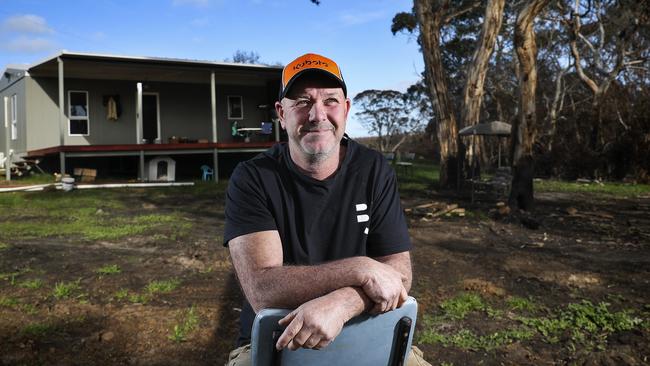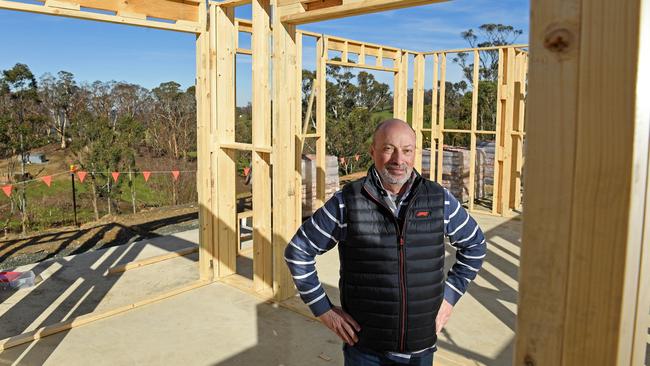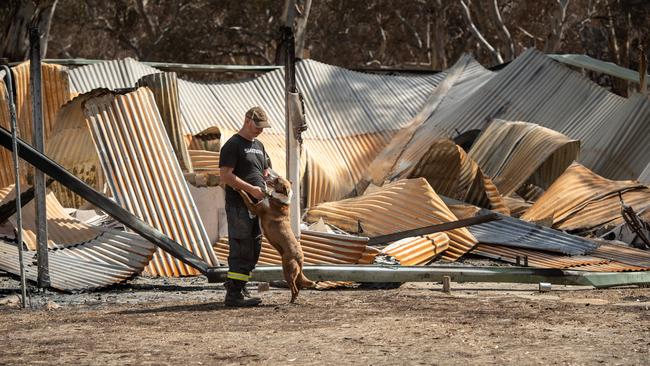For 12 months, we’ve followed their journey. Now two bushfire victims from the Hills and KI chronicle the highs and lows of rebuilding their homes, and their lives.
Today marks 12 months since SA’s Black Summer bushfires were declared finally safe. During the past year, SA Weekend and advertiser.com.au have followed the recovery process of Adelaide Hills couple Enrico and Sophia Sgarbi, and Kangaroo Island garlic farmer Shane Leahy. Here are their stories.
PART 1: FIRESTORM IN THE HILLS
There’s a ceramic vase sitting in pride of place in a custom-made niche in the wall of the sparkling new Adelaide Hills home of Enrico and Sophia Sgarbi. It’s not the prettiest-looking pot by any stretch of the imagination. It’s cracked and melted – a far cry from the beautiful vase Enrico admits he probably paid too much for when he bought it from Adelaide art centre JamFactory about 40 years ago.
But this pot’s a survivor. This pot was once also on display in the couple’s previous home – before that home was gutted by the raging inferno which ripped through the Cudlee Creek region on December 20, 2019.
On that night, the Sgarbis lost nearly every material possession they owned. Their home. Six classic cars. Two other cars. A ute. The garden they had meticulously created as a family with their now-adult children. Family photos dating back generations. About 600 bottles of wine. And 130 litres of homemade passata.
When they fled those deadly flames on that hot, horrible, unforgettable, unimaginable day, they fled with nothing but the clothes on their backs.

So they lost the lot. Everything. Well, almost everything.
The pot that now sits proudly in that recess near the snug of the new dream home they built somehow survived. So did the pizza oven out the back that Sophia had given Enrico a decade ago for his 50th birthday.
And so now, three months after moving into the new home they built on the same patch of land which had housed the home they had lived in for the previous 20 years, the couple reflects on that pizza oven and that pot with reverence.
They discovered the vase was still intact as they were picking through the rubble of what the blaze left behind. It was hidden under the crumpled ruins of their split-level home, which had once enjoyed picture-perfect views atop a hill a few kilometres from Lobethal.
“As I was going through the remnants of the home I found the vase intact – cracked, but intact,” says Enrico, now 60. “The roof had fallen, the top floor fell on it. It fell off the shelf down to the ground. The roof landed above it. And I thought ‘Oh my God, it’s a survivor’.

“So I crawled under the roof sheets and got it, and now it’s in our bedroom.
“That and the pizza oven were the only things that survived. Nothing else. No jewellery, nothing. Everything was gone.”
But, out of the ashes, the Sgarbis have rebuilt. Their home and their lives. They’ve spent the past 12 months almost entirely focused on the rebuild. They took a year off from running their successful business, EnviroTemp, which supplies products to improve efficiency in reverse-cycle airconditioners.
And they received the keys to their pristine new home on November 13, becoming among the first of the more than 200 SA bushfire victims who lost their home last summer to do so.
PART 2: DEVASTATION ON KANGAROO ISLAND
Over on Kangaroos Island, garlic farmer Shane Leahy, 47, has had other priorities.
The Parndana Fire Brigade lieutenant had already spent two weeks battling fires on the western half of the island when his home went up in flames on January 3, during a firestorm which ultimately claimed 119 houses.
He continued fighting fires round the clock for the next two weeks, couchsurfing between the fire station and friends’ homes, while coming to terms with his own devastating loss.
The blaze had gutted his home and all of his possessions. But, miraculously, Leahy’s garlic shed had survived, and he made the conscious decision to direct his energy towards saving the fledgling business before thinking about rebuilding his home.
Over the previous 18 months, Kangaroo Island Fresh Garlic had gradually made a name for itself, providing quality, pesticide-free garlic products. It’s a business he had dreamt up over a few beers with good mates Lachie and Sam Hollitt.
The trio figured there was a market for KI-grown garlic, and set the wheels in motion to create a joint venture.

They did their research and were preparing to plant their first crop when Sam Hollitt was killed in a car crash. Leahy and Lachie Hollitt were too devastated to go ahead with the crop that year but regrouped and were preparing to start the business in Sam’s honour when Lachie fell ill with testicular cancer. He died nine months later.
Leahy decided the boys would have wanted him to push ahead with the garlic enterprise, and all of the 2019 crop was sitting in wooden boxes in a sorting shed about 100m from his home when the fire raged through.
Army crews on the island as part of Operation Bushfire Assist chipped in to help prepare that crop for market, but then a global pandemic crippled the catering industry the farm had supplied, forcing Leahy to change his focus to a growing online market.
“After the devastation in January, the first thing I looked at was the garlic surviving and the business that was in front of me,” he says.
“The only thing that survived was the garlic, so from day one, I focused on that. It was always in my head that the garlic business had to be the hero of my life now. The fires have pushed me and forced me, in a lot of ways, to make sure this works.”
Leahy bought himself a laptop and printer and ran the business out of a donated caravan he lived in for five months after the blaze, before accepting an offer from Sydney-based rapid housing company Lift Link to supply him with a two-bedroom home.

He moved into the modest structure, erected over eight weeks about 50m from his previous house, at the start of June. The initial plan was for this building to be a temporary living space but as the year progressed, the urgency to rebuild on the site of his former home dissipated.
“Living in the caravan was never going to be an option as a permanent thing,” Leahy says. “Trying to run a business and trying to live a life out of a caravan, it’s hard work. It’s all right if you’re on holidays, but you can’t permanently live there as a life.
“(Initially) I thought of this little house as temporary accommodation, and then I would need to rebuild a home. But as we’ve lived here over the past six or seven months its becoming very comfortable.
“I’d be quite comfortable here for two or three years, until I’m very confident of how I want to rebuild. I haven’t had time to do plans for a house … so I’ll be quite happy living here for the next couple of years. The rebuild will come over time, rather than getting forced into it because I need somewhere to live.”

It was a far different story for the Sgarbis, who were determined to be in their new home by Christmas 2020. The inferno had ruined one Christmas; they were adamant that it would not ruin another.
Enrico Sgarbi set the wheels in motion for their rebuild before the fire even hit. He called his insurance agent as they were fleeing their property to let him know their home was under threat. Later that night, still reeling after hearing from neighbours the house had been razed, he was back on the phone to the agent to confirm their loss.
He emailed a builder on December 23 and had signed a contract by New Year, determined to be at the front of the queue when the rebuild in the Hills began.
The couple had previous looked into building a holiday home at Wallaroo, which ultimately failed to eventuate, and had then briefly contemplated selling their Lobethal district property to build their dream home on a virgin block of land, so they had a firm idea of what the new house should include.

And, most importantly, they had a simple but solid plan to protect their assets in case of a fire: pay a premium for top-level insurance and evacuate early to save their own lives.
“Every year, around November or December, I would go back through the year and look at what we had accumulated and what we’d done, and I’d ring my insurance agent,” Sgarbi says.
“I’d always adjust my insurance. Insurance, for me, is an investment. So the day the bushfires started, I felt safe inside. I knew that our assets and the security of our future home was protected.”
And so, within weeks of their gutted house being cleared and as the Sgarbis took up residence in a fortuitously vacant rental home directly across the road, their new house started taking shape.
They had invested two decades and hundreds of thousands of dollars painstakingly moulding their 1.4-hectare property into their own piece of paradise, but had been concerned the split-level home they bought when it was near-new back in 2000 might become too hard to handle when they entered their twilight years – hence the dalliance with building a new home a few years ago. So the silver lining to that horrific day was being able to build the vast, single-storey house they had always dreamt about on the site in which they had invested so much.

They enjoyed the small bursts of excitement throughout the year, as the builders reached various milestones, but, looking back, say it is something they never again want to experience.
“Thankfully, everything happened smoothly,” Sgarbi says. “There were no major complications … But now, in reflection ... it was a hard year.
“I said many times that we were OK, and at that moment we were, but now we think backwards, it’s like, ‘How on earth did we have the strength to get through that?’. It’s like we were numb for 11 months.”
For months, he would wake in the middle of the night, suddenly remembering a job he needed to complete before the next stage of the building process could proceed.
“My father always told me that the true test of a man is how he can manage himself during adverse conditions – and this is definitely an adverse condition,” Sgarbi says. “I hope I am managing things OK.”

The result of his sleepless nights and relentless focus is an expansive and impressive four-bedroom home with high ceilings and plantation shutters throughout. Large windows make the most of the hilltop views and the home features a wine room, studio, massive master bedroom with a retreat, walk-in robe and a bathroom as large as their previous bedroom. The surviving pizza oven dictated the exact location of the home and is incorporated into a large outdoor patio which features, as pavers, a few salvageable bricks from the original home.
The Sgarbis have gone above and beyond regulations to make the home bushfire safe. There are no eaves or verandas to catch the wind, and no exposed wood. Every appliance, every piece of furniture, is new.
“As friends come and visit and see everything in the house is new, they’re going to think, ‘Wow, this is very nice and this is very nice – what did you spend for this?’,” Sgarbi says. “My wife’s already prepared her response: ‘What did it cost us? Everything’. And that’s exactly what it cost us: everything. Although we’re going to get a big, beautiful home … at the end of the day we paid a huge price.”

Shane Leahy’s modest home among the gum trees north of Parndana is far less grand, but after months living in a caravan, he’s just happy to have a solid, permanent roof over his head.
“You don’t appreciate how much a hot shower means, or being able to go to the toilet in a house,” he says. “Being able to get out of the shower and have a warm environment to get back into ...
“You don’t realise how simple your life is when you’ve got a house with all those things. Every day you walk in, take your boots off, walk into the house, have a shower, come out and cook your dinner.
“You don’t realise how easy that is. It doesn’t matter how big your house is or how small. It’s your home. The caravan is not a home.”
Like Sgarbi, Leahy has had little time to stop and reflect on the trauma of losing his home during the relentless process of recovery. “I’ve been so busy with readjusting to everything ... I haven’t had time to sit there and think ‘Wow – what happened?,” he says. “You just don’t have time to reflect on that bad things did happen ... it’s just been constant. You don’t switch off.

“I don’t know how long it can go on before you have a meltdown, but at the moment, yeah, I’m going really well.”
But for a couple of weeks early in the process of organising his insurance claim, that wasn’t the case. Leahy’s insurance company approved the claim but his bank refused to release the money because he had a small mortgage remaining.
“My mental health deteriorated very, very quickly in those couple of weeks, because I thought I wasn’t going to receive any insurance money,” he says. “And that was devastating. What had I done wrong for them not to give me my money? I couldn’t fathom it.
“And I couldn’t talk to anyone there, either – you’re talking to brick walls. So that was pretty sad. The bank was probably my biggest upsetting thing through the whole experience.”

But both men are full of praise and thanks for the help they’ve received from governments, charities and their communities – especially considering the extra burden COVID-19 restrictions placed on society in 2020. The pandemic-enforced cancellation of local sport was a massive blow for the isolated KI community, which traditionally comes together on weekends, especially in winter for football and netball. The island’s tourism sector is slowly bouncing back after it was crippled by both bushfires and COVID, and many farmers hit hard by the fires enjoyed one of their best seasons in years.
“The community spirit … the community on Kangaroo Island … how everyone has bonded together in the last 12 months,” Leahy says when asked to reflect on the past 12 months. “I’m sure it’s the same in a lot of country areas, but it just shows the good heart of people in the community, and even right across Australia.”

He and the Sgarbis understand the consequences of choosing to rebuild on properties in areas proven to be susceptible to the terrors of fire. They know it might happen again one day. They accept that risk. It’s one they are willing to take to enjoy the beauty of living among the Australian bush.
“I supposed the biggest fear (heading into this bushfire season) would be for our own safety,” Enrico Sgarbi says. “We already lost everything. The worst we can lose now is ourselves. Our safety, our health, our pets. If another bushfire came through, we’ll do the same thing. We’ll leave. We’ll make sure our property is protected. It’s definitely bushfire ready. I hope it doesn’t happen again. But if it does, we’re ready.”
Leahy says coming into this bushfire season “is actually still quite scary”. “I think a lot of people probably thought that after what we’ve gone through … that for the next five years we don’t have to worry too much about getting burnt out, he says. “But we’ve had a really good season as far as rainfall and the growth of grass and crops and trees. That danger is still there.”



Add your comment to this story
To join the conversation, please log in. Don't have an account? Register
Join the conversation, you are commenting as Logout
Lunch at the uni earns a distinction
A $30 steak is the most expensive thing on the menu at a polished restaurant in the heart of academia.
My boyfriend dumped me using ChatGPT
We’ve all felt the pain of a break-up, those stomach knots when your partner says, “we need to talk”. But have you been broken up with via AI?